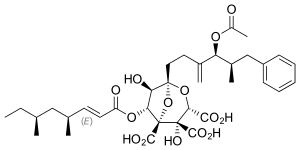Zaragozic acid
Zaragozic acids are a family of natural products produced by fungi. The first characterized zaragozic acids, A, B, and C were isolated from an unidentified sterile fungal culture, Sporormiella intermedia, and L. elatius, respectively.[1] just outside the European city Zaragoza, Spain on the Jalón river. This family of natural products possesses a unique 4,8-dioxabicyclo[3.2.1]octane core, and vary in their 1-alkyl and their 6-acyl side chains.[2]
 | |
| Names | |
|---|---|
| IUPAC name
(1R,2S,3S,5S,6R,7R)-5-[(4S,5R)-4-acetoxy-5-methyl-3-methylene-6-phenylhexyl]-7-[(E,4S,6S)-4,6-dimethyl-1-oxooct-2-enoxy]-2,6-dihydroxy-4,8-dioxabicyclo[3.2.1]octane-1,2,3-tricarboxylic acid | |
| Other names
Squalestatin 1 | |
| Identifiers | |
3D model (JSmol) |
|
| ChEBI | |
| ChEMBL | |
| ChemSpider | |
PubChem CID |
|
| UNII | |
| |
| |
| Properties | |
| C35H46O14 | |
| Molar mass | 690.73134 |
Except where otherwise noted, data are given for materials in their standard state (at 25 °C [77 °F], 100 kPa). | |
| Infobox references | |
Uses
Zaragozic acids are potent inhibitors of S. cervisiae, fungal and mammalian squalene synthase and therefore inhibitors of sterol synthesis.[2] Squalene synthase is the first committed enzyme in sterol synthesis, catalyzing the reductive condensation of farnesyl pyrophosphate to form squalene.[3] As a squalene synthase inhibitor, zaragozic acid produces lower plasma cholesterol levels in primates.[2] Treatment of rats with zaragozic acid A caused an increase in hepatic low density lipoprotein (LDL) receptor mRNA levels.[4]
Zaragozic acids also mildly inhibit Ras farnesyl-protein transferase.[5]
Zaragozic acid D and D2 have been isolated from the keratinophilic fungus Amauroascus niger.[5]
Biosynthesis
The core biosynthetic route is via a polyketide synthase pathway from 10 acetates, 4 methyls of methionines, 1 succinate, and 1 benzoic acid.[6]
References
- Bergstrom JD, Kurtz MM, Rew DJ, Amend AM, Karkas JD, Bostedor RG, Bansal VS, Dufresne C, VanMiddlesworth FL, Hensens OD (January 1993). "Zaragozic acids: a family of fungal metabolites that are picomolar competitive inhibitors of squalene synthase". Proc. Natl. Acad. Sci. U.S.A. 90 (1): 80–4. doi:10.1073/pnas.90.1.80. PMC 45603. PMID 8419946.
- Bergstrom JD, Dufresne C, Bills GF, Nallin-Omstead M, Byrne K (1995). "Discovery, biosynthesis, and mechanism of action of the zaragozic acids: potent inhibitors of squalene synthase". Annu. Rev. Microbiol. 49: 607–39. doi:10.1146/annurev.mi.49.100195.003135. PMID 8561474.
- Do R, Kiss RS, Gaudet D, Engert JC (January 2009). "Squalene synthase: a critical enzyme in the cholesterol biosynthesis pathway". Clin. Genet. 75 (1): 19–29. doi:10.1111/j.1399-0004.2008.01099.x. PMID 19054015.
- Ness GC, Zhao Z, Keller RK (June 1994). "Effect of squalene synthase inhibition on the expression of hepatic cholesterol biosynthetic enzymes, LDL receptor, and cholesterol 7 alpha hydroxylase". Arch. Biochem. Biophys. 311 (2): 277–85. doi:10.1006/abbi.1994.1238. PMID 7911291.
- Dufresne C, Wilson KE, Singh SB, Zink DL, Bergstrom JD, Rew D, Polishook JD, Meinz M, Huang L, Silverman KC (November 1993). "Zaragozic acids D and D2: potent inhibitors of squalene synthase and of Ras farnesyl-protein transferase". J. Nat. Prod. 56 (11): 1923–9. doi:10.1021/np50101a009. PMID 8289063.
- Chen TS, Petuch B, MacConnell J, White R, Dezeny G, Arison B, Bergstrom JD, Colwell L, Huang L, Monaghan RL (November 1994). "The preparation of zaragozic acid A analogues by directed biosynthesis". J Antibiot (Tokyo). 47 (11): 1290–4. doi:10.7164/antibiotics.47.1290. PMID 8002393.